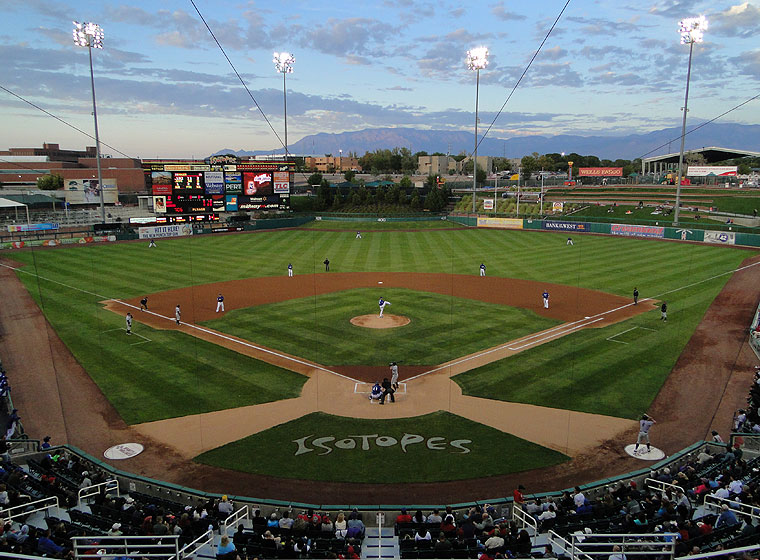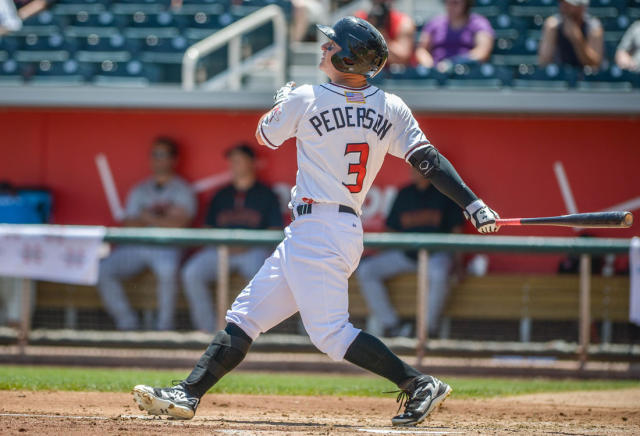The Albuquerque Isotopes have been the Dodgers Triple-A affiliate for the past six years but 2014 proved to be the final year of that affiliation – one that will most likely never be renewed.
The Isotopes play in the Pacific Southern Division of the Pacific Coast League. In 2014 manager Damon Berryhill saw his squad struggle to a 62-80 record a full 18 games back of the division leading Las Vegas 51s. Many of the games were high scoring affairs with the Isotopes often falling a run or two short although they began the season on April 4th with an 11-1 loss to the Tacoma Rainiers and finished it on September 1st with a 5-1 loss to the Las Vegas 51s.
Offensively the Isotopes were in the top third of most statistical categories in the 16 team league. They packed some punch with a team batting average of .283 while leading the league with a .463 SLG percentage. Their 169 home runs and OPS of .816 were second only to those accumulated by the Las Vegas 51s.
On the mound a different story unfolded. The Isotope staff finished almost dead last with an ERA of 5.50 and a WHIP of 1.58. Their 749 earned runs allowed were the third most in the league while their strikeout total of 976 was the second lowest total in the league.
However, the season was not without its moments. The fans in Albuquerque continued to support the team as 564,625 passed through the turnstiles for an average attendance of 8,066.

Although the Dodgers have a rich history with the beautiful city of Albuquerque, its mile high elevation was a big reason why they did not renew their Player Development Contract to continue playing at Isotopes Park.
(Photo courtesy of baseballpilgrimages.com)
Andy Mantsch, Stadium Journey Special Correspondent, provided the following summary regarding the charm of baseball in Albuquerque: “Unique is the key word that seems to define Isotopes Park in Albuquerque, and it doesn’t end with the “The Simpsons”-themed team name and statues around the park. From the concave center field berm in front of a right field family fun park to a New Mexico Green Chile Dog from Pecos River, a ‘Topes game offers a wide variety of attractions for the whole family.”
In his final thoughts Mantsch summed up up the Isotope experience:”Isotopes Park is definitely one of the nicer venues in minor league baseball and is full of character. There is a distinct New Mexico feel to the food, the entertainment and the fans that gives it that local charm that often lacks in larger parks. This is definitely worth the visit if you’re bringing the whole family, or just wanting to kick back and watch some quality professional baseball.”
On the field 22-year old Joc Pederson provided much of the excitement. He produced a triple slash of .303/.435/.582 along with an OPS of 1.017. During the 2014 season the center fielder led all of Triple-A in home runs, on-base percentage, slugging percentage, walks and runs scored.

It will be impossible not to think of Joc Pederson when you think of the Dodgers final season affiliated with the Albuquerque Isotopes. (Photo credit – Roberto E. Rosales)
The Palo Alto, California native and son of former Dodger Stu Pederson became the fourth player in the Pacific Coast League’s 112-year history to record at least 30 home runs and 30 stolen bases in the same season. He became the first player to accomplish the feat since 1934.
As a result of his break through season Pederson was named the league’s Rookie of the Year, an All-PCL all star as well as the league’s Most Valuable Player.
Besides providing entertainment for the loyal fans in Albuquerque, the primary function of the Triple-A team was to provide a venue for players to continue their progression towards major league baseball and provide depth for the parent team.
In 2014 a number of players contributed to the success of the Dodgers’ season either as replacements during the season because of injuries to Dodger regulars or as September call ups.
Pitching support for the Dodgers roster was provided by: Carlos Frias, Red Patterson, Yimi Garcia, Stephen Fife, Jose Dominguez, Pedro Baez. Baez perhaps made the most significant contribution and enhanced his chances of breaking from spring training with a spot on the Dodgers 25-man roster. Unheralded Yimi Garcia made an impression in his eight appearances with the Dodgers.
Defensive and offensive replacements following the pipeline to Los Angeles in 2014 included: Clint Robinson, Jamie Romak, Alex Guerrero, Tim Federowicz, Miguel Rojas, Mike Baxter, Roger Bernadina, Erisbel Arruebarrena and Joc Pederson. One highlight for the replacement players was Clint Robinson’s first major league hit on June 30th in an inter-league game against the Cleveland Indians. Robinson’s hit was an RBI single driving in the only run in a 1-0 victory over the Indians.
On September 17th the announcement was made that the Dodgers Triple-A affiliation in 2015 would be with the Oklahoma City RedHawks and not the Albuquerque Isotopes. A subsequent announcement revealed that the the new affiliate would be renamed – the Oklahoma City Dodgers. The name change was indeed a welcome announcement .
It is with a touch of sadness to realize that Albuquerque will no longer be connected to the Dodgers. The ties between the two have been long and successful, especially from the 1970’s through the 1990’s. Just as old timers such as myself will never forget the Brooklyn Dodgers, we also will never forget the Albuquerque Dukes and Isotopes and the part those teams have played in Dodger history.
A new chapter has begun with the Oklahoma City Dodgers and also with the Albuquerque Isotopes who are now an affiliate of the Colorado Rockies.
Best wishes for continued success to the Isotopes, their loyal fans and their new manager former Blue Jay Glenallen Hill. The disclaimer of course is except when they play the Oklahoma City Dodgers towards the end of August at Isotopes Park.
(Author’s Trivia Note: Glenallen Hill actually played for five major league teams and in Chicago is remembered for his May 11, 2000 home run that not only made it out of Wrigley Field but across Waveland Avenue and onto the roof of a building across the street).




 January 18th, 2015 at 6:00 am
January 18th, 2015 at 6:00 am  by Harold Uhlman
by Harold Uhlman  Posted in
Posted in 

Although Albuquerque has been a huge part of Dodger history, the move to OKC is much more practical, especially with their new Double-A affiliate only 100 miles away. I expect that the move will make the Triple-A affiliate much more involved in the progression to the big leagues than it has been in many decades.
Nice work Harold.
I don’t quite understand why the minor leagues have become a shell game, with teams moving their affiliations between a fixed set of cities. The Dodgers needed to leave Albuquerque since the altitude skewed results for both pitchers and hitters (note that for several years the Dodgers have promoted their top pitching prospects from AA instead of AAA), but why couldn’t they relocate to a place of their choosing closer than 1187 miles? And why are the Rockies going to play in Albuquerque and the Astros play in Fresno? Although I can see the Rockies and Albuquerque, both mile high.
I know it’s an old cliche but it definitely applies to MiLB just as it does MLB – It’s all about the money.
Cities try to lure MLB organizations to bring their minor league affiliates to their existing ballparks (hence the same locations over and over again) with hopes of landing a team that will increase attendance. It pretty much goes without saying that the Dodgers are among the most sought-after clubs.
Because it costs so much to build (and maintain) a MiLB ballpark, there are very few cities willing to do so. It is not the parent company who pays for this, although some franchises often help with stadium renovations.
Interestingly, the Dodgers always seems to land at the better MiLB ballparks with their PDCs. A classic example occurred in 2011 when the Dodgers and Angels swapped their Cal League (Advanced Single-A) ballparks. No disrespect to San Bernardino, but The Epicenter (now called LoanMart Field) in Rancho Cucamonga is a much nicer facility than San Manuel Stadium.
I, too, wish there was a nice (available) Triple-A ballpark closer to Dodger Stadium, but there simply is not. It seems that the hated Giants have snatched them all up.